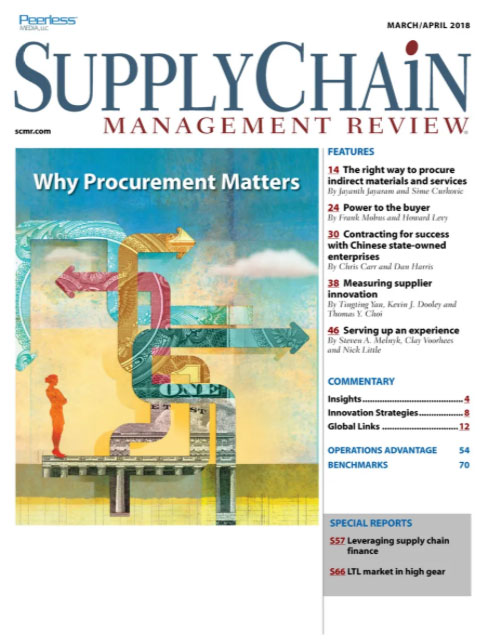Sorry, but your login has failed. Please recheck your login information and resubmit. If your subscription has expired, renew here.
March-April 2018
"Inflation creeps into U.S. Supply Chain.” So said the headline on a Wall Street Journal article I read this morning before writing this column. The Journal went on to write that U.S. companies are grappling with rising material and ingredient costs on top of pressure from higher wages—a potential double whammy— and noted that companies like Whirlpool and Ford have already issued warnings to the market. Browse this issue archive.Need Help? Contact customer service 847-559-7581 More options
In a business climate where optimizing cash flow, lengthening payment terms and preserving financial assets have become strategic imperatives for most companies, supply chain, or supplier, finance is gaining in popularity across the global supply chain. Through a “reverse factoring” process, this financing option finds suppliers “selling” their invoices to a bank or other entity at a discount, and then paying those invoices later while suppliers get paid earlier.
Rather than relying on the individual supplier’s credit, the middleman (usually a bank) deals directly with the buyer. A large, global manufacturer, for example, can use supply chain finance to pay its suppliers later, thus boosting its own working capital while holding onto its cash for a longer period of time.
In a best-case scenario, both supplier and buyer improve their own working capital while the middleman receives a fee for its services. And because the risk is transferred to one buyer (versus a group of buyers, as in the case of factoring), it tends to be a less expensive and less risky proposition. Through it all, the end game is to give suppliers access to beneficial financing options as a result of the buyer’s good credit rating.

This complete article is available to subscribers only.
Log in now for full access or start your PLUS+ subscription for instant access.
SC
MR
Sorry, but your login has failed. Please recheck your login information and resubmit. If your subscription has expired, renew here.
March-April 2018
"Inflation creeps into U.S. Supply Chain.” So said the headline on a Wall Street Journal article I read this morning before writing this column. The Journal went on to write that U.S. companies are grappling… Browse this issue archive. Access your online digital edition. Download a PDF file of the March-April 2018 issue.In a business climate where optimizing cash flow, lengthening payment terms and preserving financial assets have become strategic imperatives for most companies, supply chain, or supplier, finance is gaining in popularity across the global supply chain. Through a “reverse factoring” process, this financing option finds suppliers “selling” their invoices to a bank or other entity at a discount, and then paying those invoices later while suppliers get paid earlier.
Rather than relying on the individual supplier's credit, the middleman (usually a bank) deals directly with the buyer. A large, global manufacturer, for example, can use supply chain finance to pay its suppliers later, thus boosting its own working capital while holding onto its cash for a longer period of time.
In a best-case scenario, both supplier and buyer improve their own working capital while the middleman receives a fee for its services. And because the risk is transferred to one buyer (versus a group of buyers, as in the case of factoring), it tends to be a less expensive and less risky proposition. Through it all, the end game is to give suppliers access to beneficial financing options as a result of the buyer's good credit rating.
SC
MR


More Finance
- Investor expectations influencing supply chain decision-making
- ISM reports manufacturing sees growth in March, snaps 16-month stretch of contraction
- Supply Chains Facing New Pressures as Companies Seek Cost Savings
- February retail sales see annual and sequential gains, reports Commerce and NRF
- A New Model for Retailer-Supplier Collaboration
- How to Create Real Retailer-Brand Loyalty
- More Finance
Latest Podcast

 Explore
Explore
Business Management News
- April manufacturing output slides after growing in March
- Q1 sees a solid finish with positive U.S.-bound import growth, notes S&P Global Market Intelligence
- 6 Questions With … Sandeep Bhide
- MIT CTL offering humanitarian logistics course
- Bridging the ESG gap in supply chain management: From ambition to action
- Few executives believe their supply chains can respond quickly to disruptions
- More Business Management
Latest Business Management Resources

Subscribe

Supply Chain Management Review delivers the best industry content.

Editors’ Picks





